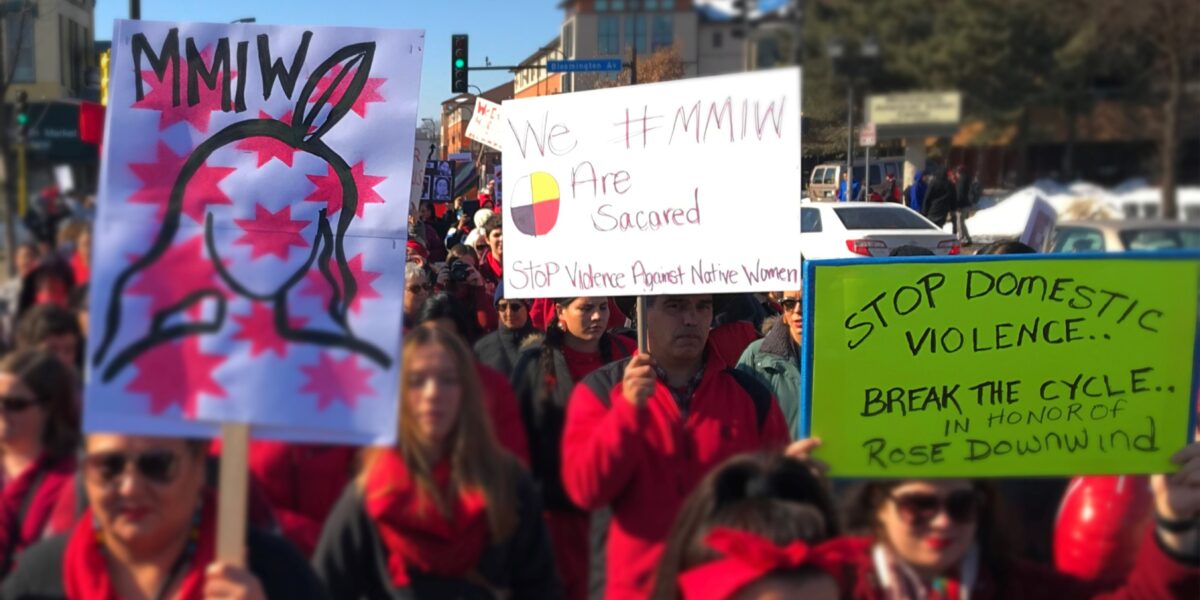This is Minnesota Native News. I’m Marie Rock. Coming up, from a 2020 report by the Minnesota Task Force on Missing and Murdered Indigenous Women, “While Indigenous people make up just 1% of the state’s population, 9% of all murdered girls and women in Minnesota from 2010 to 2019 were American Indian.”
February 14th marks a day of honoring for those who are missing and murdered. Events are held, bringing awareness to the epidemic. This year during the pandemic, some events are now online. What is consistent is the support shared for one another and the color red, which is often worn and used in art and signs.
Reporter Leah Lemm speaks with three survivors about the significance of the color red in the search and honoring of Missing and Murdered Indigenous Women and Relatives.
Reporter: Thanks for taking some time today to talk with me about Missing and Murdered Indigenous Women and Relatives. Can you each please introduce yourself starting with Jessica?
Jessica Smith: [Ojibwemowin]. My name is Jessica Smith. I am a two-spirit enrolled member of the Bois Forte Band of the Minnesota Chippewa tribe. I am a survivor of human trafficking, sexual assault and domestic abuse. So I work with Sovereign Bodies Institute. I’m on their survivor leadership council and all the work that I do nationally is surrounding those issues and how they correlate with the epidemic of Missing and Murdered Indigenous People.
Mysti Babineau: Hello, my name is Mysti Babineau. I am a citizen of the Red Lake nation. Like Jessica, I’m a survivor of trafficking, sexual assault, violence, domestic violence, and I’m a climate justice organizer.
Taysha Martineau: [Ojibwemowin]. My name is Taysha Martineau. I am a two-spirit Indigenous rights anarchist from the Fond du Lac reservation. I am a single mother of four and I’m a survivor of abuse.
Reporter: Miigwech for sharing. In attending the rallies and marches and other honorings myself, red is a significant color. Signs, clothing, ribbon, skirts, and red dresses are often displayed. Can you talk a bit about the significance of red and the red dresses?
Jessica Smith: Red is, we are told, that is the only color that spirits can see. So by wearing red or putting out these red dresses is to call back the spirits of these women and allowing their voices to be heard through our bodies and do the things that we do.
Mysti Babineau: Just like Jessica said, that’s what I was taught too. And also that’s just a very sacred color, at least to the Ojibwe people. We often use it for protection as well, and I think that’s also the thing that’s really beautiful about our culture and our traditions is the way that they can also shift.
Taysha Martineau: So when we wear red, we’re calling those spirits back to us. We’re wearing that red so that they come to us so that while we’re searching for them, they know who it is we’re calling.
Reporter: And wearing a red dress and displaying red dresses are a continuation of that?
Jessica Smith: The red dress project and everything that stemmed from that actually originated in Canada from a woman named Jamie Black. It started out as just a project to show that these women are missing.
Taysha Martineau: The red dress signifies women and it signifies solidarity with the families who are going through this with those mothers who are sitting at home, just waiting for a phone call. The MMIW epidemic has been an epidemic since first contact, and that color, it signifies not only that a woman’s missing, but it signifies our love for that person and our love for that family and our support for them.
Reporter: So red is a call to spirits and showing solidarity with those lost and their loved ones and community. Well, thank you, Jessica Smith, Mysti Babineau, and Taysha Martineau for sharing today.
If you need help, there are free resources available.
Strong Hearts Native helpline (www.strongheartshelpline.org) provides culturally appropriate support and advocacy for American Indians and Alaskan natives. Their hotline is 1-844-7NATIVE. It’s anonymous and confidential. That’s 1-844-762-8483.
Also, the National Human Trafficking Hotline: 1 (888) 373-7888 or humantraffickinghotline.org
Leah Lemm reporting for Minnesota Native News


 Visiting Vaccines with Daniel Frye, Jenn Hall, and Kelly Miller
Visiting Vaccines with Daniel Frye, Jenn Hall, and Kelly Miller
[…] The Color Red for MMIWR […]